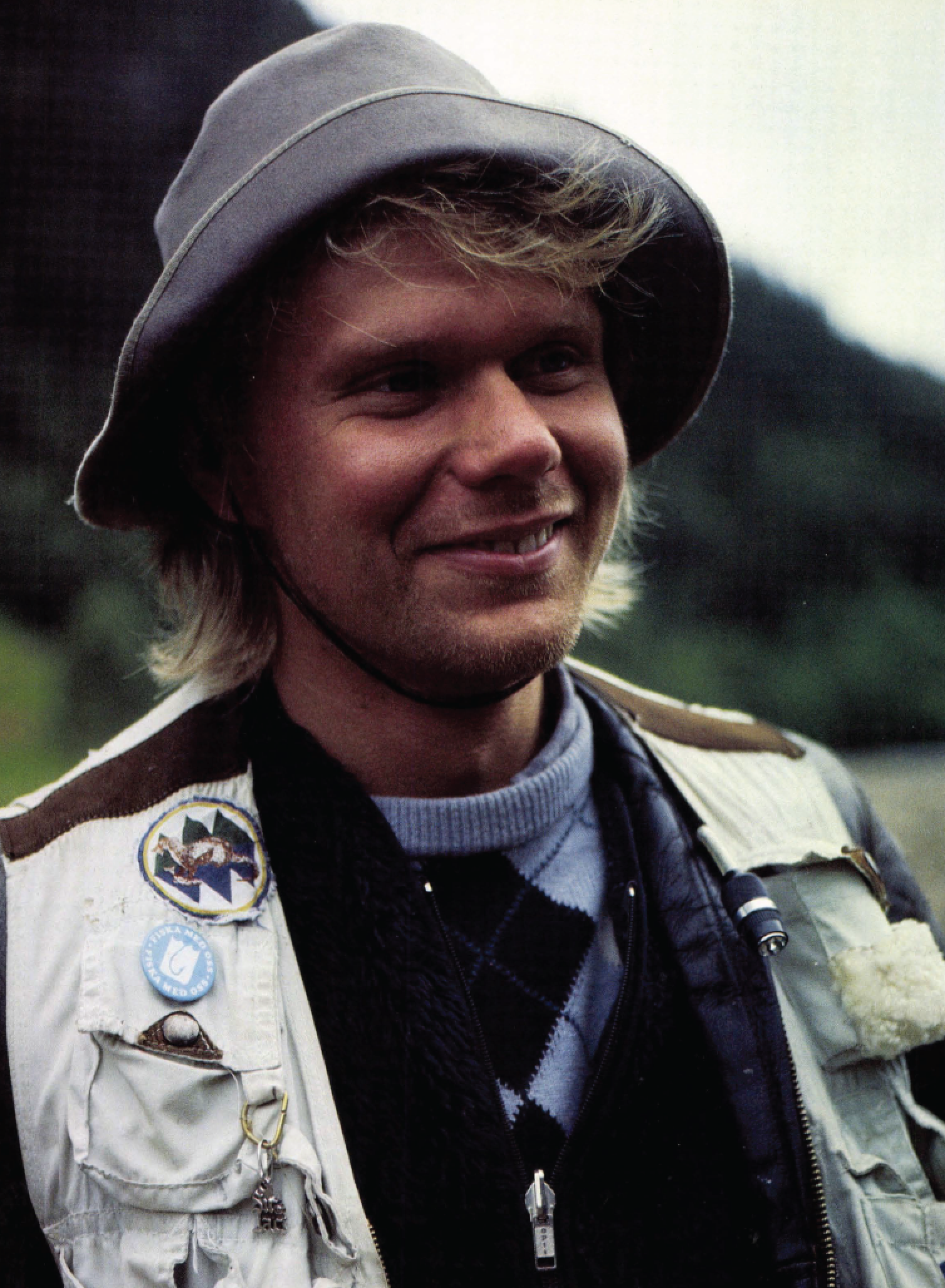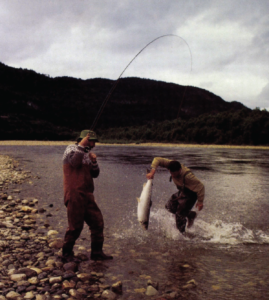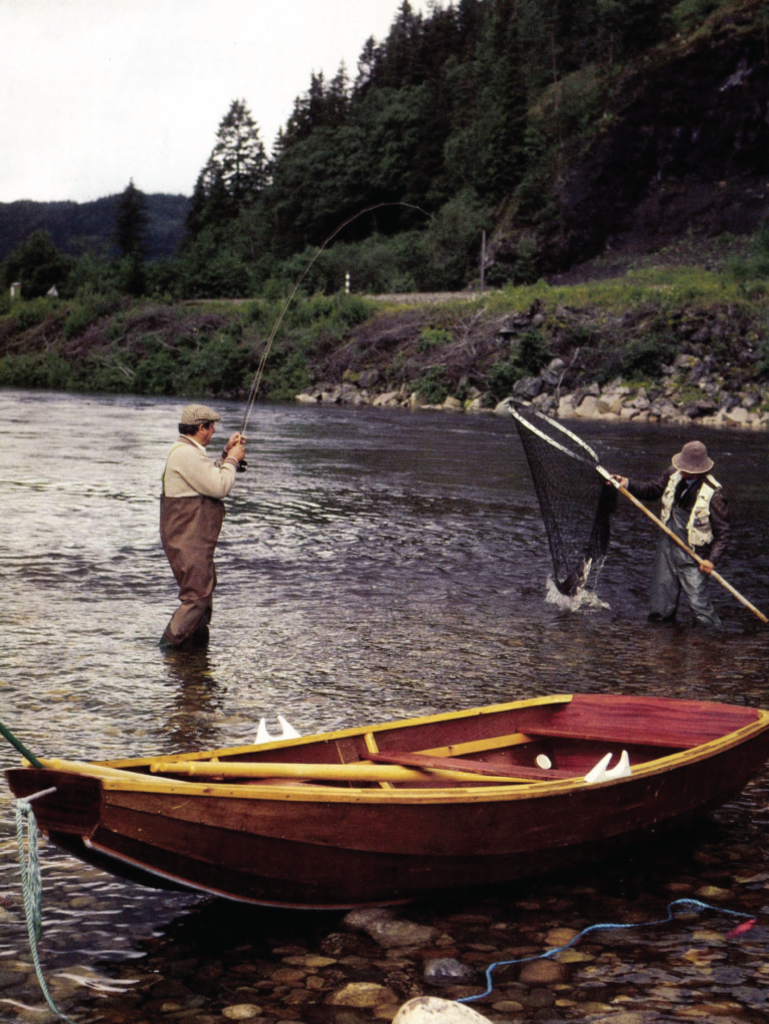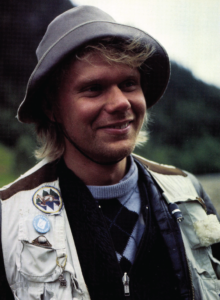Norwegian Silver
April 1, 2021



 Fishing,SCA Articles
Fishing,SCA Articles

If you fish for the challenge and sport, try Norway’s Gaula River where a 25-pound Atlantic salmon is common but every cast offers the chance to take a 40 pounder.
There are salmon common to the dreams of all salmon fishermen, huge fish that fin nervously in great shadowy pools; that leap, flashing silver-gold in a late afternoon sun. They swim through our mind , etching an image of bulk and strength, for they are the salmon of a lifetime. Such fish , such dreams are the reason salmon fishermen endure the discomforts and expense of salmon fishing.
 Far out into the vast torrent that makes up the Gaulfoss pool, such a fish surfaced, then with several powerful head shakes began his run toward the rapids in the distance. Suddenly, the click drag of the fly reel fell silent and the reel began free spooling. So did the advice. Instructions were simultaneously being shouted at me by my fishing companions from New York and California, our three Swedish guides and the Norwegian film crew which was filming the developing comedy. I would have enjoyed the scene more had I not been on the verge of panic as the 20-pound plus salmon continued to take line in a sweeping arc across the pool. Slowly I regained the line using only my fingers against the spool for drag against the strong and stubborn salmon. Never again would I use someone else’s tackle just so I could get to the river more quickly .
Far out into the vast torrent that makes up the Gaulfoss pool, such a fish surfaced, then with several powerful head shakes began his run toward the rapids in the distance. Suddenly, the click drag of the fly reel fell silent and the reel began free spooling. So did the advice. Instructions were simultaneously being shouted at me by my fishing companions from New York and California, our three Swedish guides and the Norwegian film crew which was filming the developing comedy. I would have enjoyed the scene more had I not been on the verge of panic as the 20-pound plus salmon continued to take line in a sweeping arc across the pool. Slowly I regained the line using only my fingers against the spool for drag against the strong and stubborn salmon. Never again would I use someone else’s tackle just so I could get to the river more quickly .
The Atlantic salmon, Salrno safar, is considered a prince among sport fish by those who fish for him with a fly rod. Dubbed “the leaper” by the Romans, this powerful acrobat has single handedly strained the fortunes and family relationships of many anglers over the past 150 years.
Some say that the serious and thoughtful fisherman goes through three distinct stages of motivation during his angling career. Initially he wants to catch as many fish as possible. Satisfied at some point, he travels in search of the largest fish he can land. After a few notable conquests he eases into the final and most mentally satisfying phase of angling; fishing for the challenge and sport.
Anglers inflicted with the incurable malady of the salmon fishermen are invariably immersed in all three stages at once. Of course, one wants to catch as many large salmon as possible; they are the most respected of game fish . In addition, the very nature of using a fly rod, compounded by spawning-run salmon that do not eat, make this port one of the most difficult.
To take a truly large salmon, one must travel to where the world’s largest strain of salmon return to the rivers of their birth. Norway, that beautiful Scandinavian country bordered by Sweden and Finland to the east and the north Atlantic Ocean to the west. To be sure, record fish are caught every year in the great rivers of Canada and Britain, but the best waters for many years have been privately held and inaccessible to the average angler. Commercial exploitation of these resources over the years has also severely depleted available fish stocks. Iceland, because of its longtime practice of conservation, is perhaps the most reliable of all salmon fisheries today, but for the most part the Icelandic salmon are smaller, and a large Icelandic salmon would be considered an average salmon in Norway. It is Norway, then, that remains the Mecca for trophy salmon.
In 1982 the world record salmon , an immense fish weighing 79 pounds, was taken in Norway’s Tana River. The largest salmon caught on a fly came from the Aroy and weighed 68 pounds. The famous Alta, located in arctic Norway and perhaps the most expensive salmon river in the world, surrenders several fish over 50 pounds yearly.
But it was to the Gaula River that I and my fishing companion, Shelly Spindel, had come to fish. Situated in Trondelag, it flows into the Trondheimsfjord located in the midsection of the country. Though not as well known as some other rivers in Norway, the Gaula in recent years has proved to be one of the most productive.
A large river about 150 miles long, the snow and rain-fed Gaula is inhabited by salmon for the first 50 miles, where they are obstructed from further ascent by the Eggafossen Falls. Running through lush green mountains and rich farm country, the Gaula gets its name from the old Norwegian word “Gula,” which means “Gold River.” The valley through which it courses is called the Gold Valley, derived from the local belief that those who settled in the area seemed to become wealthy after their association with the river. The land is certainly fertile, but much of the wealth probably resulted from the discovery of its salmon treasury by the British in the 1860s and 1870s. They began to lease the best waters from the farmers that owned the valley, and by the turn of the century the Gaula was considered one of the best salmon rivers in Norway.
In the Gaula a 15 to 25-pound salmon is common, although many 30 and 40 pounders are taken each year. Grilse (young salmon spawning for the first time) represent only five to ten percent of the fish population in the river. In 1983 two fish weighing over 50 pounds were taken, and on opening day of that year six anglers who fished one pool, the Gaulfoss, landed 48 salmon averaging 21 pounds each. Over the years the Gaula has annually averaged an incredible 25 tons of salmon taken by rod and reel. The numbers may not be as impressive as those of other countries like Iceland or Labrador, but every cast offers the chance to take a 40-pound salmon or assuredly a fish per day for most anglers.
Unlike many other Norwegian salmon rivers, the Gaula is a comfortable river to fly fish. Its water is not as violent as some of the more recognized streams and therefore can be fished for the most part with floating line. Only during the early season , when the Gaulfoss pool becomes an impassable rapid for the salmon, does the fishing dictate heavy sinking lines, harling from a boat and very large flies. This, however, is a fantastic time to fish since an entire run of early and very large fish are concentrated in single pools.
Johan Abelsson and Ted Dalenson of Stockholm, Sweden, lease nearly 20 miles of private water to American fishermen: 13 miles on the Gaula itself and seven miles on the Bua tributary. Thi particular stretch of water holds 10 of the Gaula’s 12 best pools, including the Fraset, Gaulfoss, Bones, Void, Vinsnes and Elvenhus.
Shelly and I recuperated from jet lag in Oslo for a couple of days, then flew to the seacoast town of the Trondheim. We were met by Ted Dalenson and Arne Flagesad, owner of the l00-year-old Storen Hotel where we stayed. The Storen, a comfortable country inn complete with health spa, is located only one kilometer from the Gaula. The hotel ‘s restaurant serves excellent food; including Norwegian specialties of moose, grouse, reindeer and salmon. Lunch consists of a buffet of herring, smoked salmon, gravlox, crayfish, cheeses and many other delicacies.
Seasoned salmon fishermen accustomed to crusty old ghillie types with 50 years of experience will be a bit shocked when they meet Ted Dalenson, Johan Abelsson and their guides. They are collectively the most talented and knowledgeable group of young guides I have ever fished with. They are all members of the Royal Swedish Fly Fishing Club, and each has accumulated years of experience on the river. They are perhaps the most fluid fly casters of all , and they are also accomplished fly tiers. Most are from Stockholm and speak excellent English, with the exception of Heikke Maneinen who knows just enough to get by. These ghillies work harder to get their clients fish than any guides I have ever seen. Roland Holmberg, our guide for most of the week, was not only extremely savvy about salmon, but easy to get along with and a good friend by the end of the week.
During our first evening on the river we were to fish the famous Fraset pool owned by a farmer of the same name. Between 75 and 100 yards wide and 200 yards long, the Fraset is a deep, beautiful stretch of water that can take three rods comfortably; one at each side of the river and another at the junction of the Gaula and the Sokna tributary at the head of the pool.
As Roland and I eased chest-deep into the pool, it immediately became apparent that some practice at distance casting back home would have been helpful, for casting on this big river would be at a premium. I found a 70-foot cast to be about average, although some salmon lies required a 100-foot cast to fish the water effectively.
Soon dusk was taking over the river and the fishermen on the other side were beginning to recede into the mist. Suddenly a tub-sized boil of water developed behind my double-hooked Green Highlander. A large salmon slashed at it and missed. I made several other casts but failed to produce another strike. Half a dozen casts later and 10 yards downriver there was another swirl behind the fly. A solid strike. A few minutes later Roland had tailed a fat seven-pound salmon (because of their size, salmon can be secured by hand just above the tai I). It was not as large as the fish that had missed the fly, but it was a respectable start to the week. I was just about to ask Roland if we should keep such a small fish (it turned out all fi h are kept) when the salmon made one last lunge and wrenched itself free. Equally incredulous as he was crestfallen, Roland was to receive barbs and jokes from the other guides for the rest of the week.
After that first night, the salmon of the Gaula refused to cooperate, which can happen on any river. We knew fish were in the river, because just when fatigue would begin to slow our casting, a 20 or 30-pound salmon would roll a few feet away and spark renewed vigour. Casting became a marathon experience.
A cloudy, rainy morning in midweek found Shelly and myself fishing the bridge p 01 of the Elvenhus beat with guide Hokan Horling. Hokan can probably best be described as a free spirit. Tall with long blond hair and a gold ring in one ear, he is hardly the image of a traditional salmon guide. He is, however, as talented and knowledgeable a ghillie as any fisherman could desire.
Shelly was to fish the upper pool, just past a long riffe; I positioned myself at the tail of the run. Within 10 casts Shelly hooked and landed a small grilse of about five or six pounds. Hokan helped Shelly, then walked down to my position. He handed me a new fly to try, a double-hooked black and yellow pattern called a sheep fly which is popular in Iceland.
Taking Hokan’s advice, I began casting to a holding lie across the river. My third cast produced a solid, swirling strike, and 14 pounds of silver Gaula salmon. Strong and fresh from the sea, the fish stubbornly bulldogged around the pool until Hokan handtailed it some 15 minutes later. A satisfying morning indeed, but again the salmon turned off and reverted to their sulking.
Toward the end of the week it began to rain , the kind of heavy soaking rain that makes rivers and tempers rise. But whereas such a soaking would normally aggravate fishing conditions, this downpour made the river rise to such an extent that the Gaulfoss became a natural resting place for all the salmon entering the river. The day before we left we were eating dinner when we got word that the fish were rolling in the Gaulfoss. Ted and Mikael Frodin, another ghillie, rushed Shelly and me to the bluff overlooking the pool. They shouted like a couple of schoolboys when they saw that the river was up several feet. We hurried down the hill and soon Shelly was out in the boat with Hokan.
Shelly and I each took a tum in the boat over Gaulfoss’s expanse (at least 400 yards wide and 300 yards long, the pool is formed by a 1,000-yard-long rapids that rushes through a rock canyon). Ted had taken over the oars by the time my big salmon struck. Yelling at me above the roar of the rapids not to touch the reel, he rowed the boat more than 100 yards to the bank. It was a smart maneuver. By not ‘ reeling when the fish struck we were able to get to shore without panicking the salmon which would have been off down another set of wild rapids. Just a I got out of the boat and started to reel, the drag quit.
I played the fish about 20 minutes before it tired enough to be landed. With three near misses and ample advice from all sides, Ted finally tailed him-22 pounds. Not the 40 pounds I had hoped for; not even my largest salmon. But still it was a handsome, fine specimen of Salrno salar. The next morning Ted and I took my salmon to the local smoker to be processed into a winter’s supply of lox. I felt as smug as anyone would feel when towing off a 22-pound fish as long as your leg. Ted noticed my expression and laughed. “Let me show you a real Gaula salmon,” he said with a smile as he opened an ice chest. “I caught this one in Gaulfoss in the early season and am sending it to my folks in Stockholm.”
It was enormous, the kind that takes up half of the trunk of your car. Already smoked and minus its head and tail, it was still larger than the one I had. In fact, it was so big it had to be curled up so it wouldn’t stick out of the ice chest. “This is what you come to Norway for,” Ted said proudly. “Forty-five pounds. You fished over fish this large every day you were here.”
All the way back across the Atlantic Ocean and to this day, the vision of that salmon sticks in my mind. But then that’s worth dreaming about.


